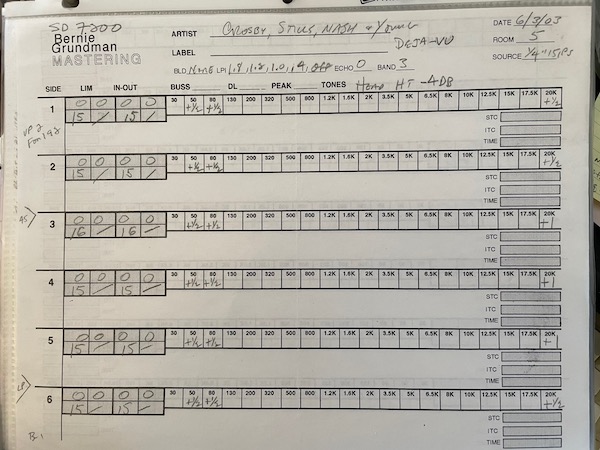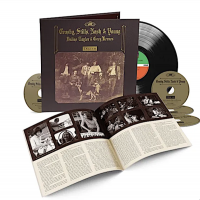Graham Nash Weighs In on Déjà vu 51 Years On
The RIAA certified seven million selling album (more recently bumped up to eight million), released March of 1970 was recorded between July 1969 and January 1970 at Wally Heider’s Studio C in San Francisco. Woodstock (the so-called “gathering of the tribes”) was that August. That was really the first time a generation experienced the “hippie-dom” togetherness (real or faux) that defined the early 1970s.
“The 60s” really happened in the ‘70s. It’s not an exaggeration to suggest that Déjà vu, with its songs of home and family provided by Nash, and Still’s opener “Carry On”—a message to the newly assembled consciousness— both reflected what was seen at Woodstock and set the tone for at least the first half of the decade, never mind that the song “Woodstock” also appears on the album.
As Nash discusses in the audio at the bottom of this review, Neil Young was asked the join in order to move the group from folk to rock and to add a second guitar to the touring lineup. Both Hendrix and Steve Winwood declined.
The always aloof Young doesn’t sing on many tracks and he mostly worked alone as he was also recording After the Gold Rush at another studio—not that Young ever was “a joiner”. Good as were Young’s contributions to this album, it could easily be argued that he brought his “B” material, some of which was recycled Springfield, though of course in most circles his “B” was “A”.
No doubt Stills was hesitant to reunite with Young after his experience in Buffalo Springfield, musically magical though were those two guitars then and here as well. The closer, a Stills/Young collaboration that spliced “Know You Got to Run” with “Everybody I Love You” (to produce “Everybody We Love You”) was perfect for the album and for the times. Fifty plus years later the record remains powerful and as vital as it was when first released. Who today produces the harmonies or the sheer power heard here?
Crosby’s almost comical, though in retrospect existential “Almost Cut My Hair” is the set’s only solo vocal and of course he provides the title tune, with its tricky meter and mystical subject matter.
More interesting for those who have consumed this record for 50 plus years are the three bonus material CDs (the set is also available in an all-vinyl edition though only the original album is AAA). A fourth CD of the remastered album serves as a reminder of why triple A vinyl still sounds and better communicates the music than does CD. At the bottom of this review, listen to the Graham Nash interview AnalogPlanet conducted with Mr. Nash. Do that first!
The well done and organized deluxe packaging features a less “pebbly” textured cover that’s a compromise between the original black and later brown jacket: it’s dark brown, though not quite black. The gatefold opens to reveal the Optimal pressed LP in a left side envelope sporting a sepia-toned cover photo variant. On the right side is a “wall” of four CDs. One contains eighteen song demos, eleven of which have never previously been released. The others were released on other compilations and one, “Horses Through A Rainstorm” co-written by Nash and Terry Reid appeared as “Without Expression” performed by Reid’s group on bang, bang you’re TERRY REID (Epic BN 26427). Another has eleven outtakes (Stills the perfectionist, who of course at the time was creatively on fire insisted upon numerous takes). A third disc contains nine alternate takes and one CD is of the original record.
Much of the bonus material ended up elsewhere in completed versions, including John Sebastian’s “How Have You Been” saga about a turtle stranded on the Long Island Expressway that was a whimsical highlight on his first solo LP, but here for the first time is the original “Know You Got to Run”, and alternative takes of “4+20”, “Woodstock” and many more, all worthy of having been included in the original album.
The set includes a nineteen page well-executed glossy sepia toned booklet—save for the first inner page, which is a full color sun-dappled band shot. Cameron Crowe, with Neil Young archivist Joel Bernstein tells the story of the album’s creation and it makes for a great read accompanied by studio and live performance photos (though for some reason no one caught the misspelling of keyboardist Mark Naftalin’s name, here spelled numerous times as “Natfalin”). The annotation puts in great perspective the turmoil surrounding the album’s creation . The centerfold reproduces the original release’s gatefold image.
As I said to Nash during the interview, I never understood the sepia toned cover photo’s Civil War theme (though as Nash points out he was not so dressed, nor was Young, who wore a Seinfeld-like “frilly pirate shirt”). For starters, The Band did this a year or so earlier and their second album actually had a civil war song! True the contentious making of this album almost caused a civil war, but it never made sense to me other than in the context of the album’s title, in which case many other potentially more interesting and original “we’ve all been here before” visuals might have hatched, but it’s what Stills wanted and given the supercharged music he wrote and produced for the album, why argue? Also confounding was the “early computer style” typeface used for the credits.
As for the original album’s remastered AAA sound, I compared two original Atlantic pressings and the Classic Records reissue to Chris Bellman’s new version. Of course with eight million copies sold, I can’t be sure my two are representative or that either is a “hot stamper” or a “poo poo platter” for that matter, but the two sounded identical though one was pressed at Presswell and the other at ME and I can’t find a reference anywhere to that!
I was wrong to think the Bernie Grundman cut Classic Records edition would sound similar to the new Chris Bellman master because both were cut on the same Scully lathe fitted with a Haeco cutter head, though of course in the interim years BG made other changed to his cutting system.
The Classic and the new version could not sound more different! Now here's an interesting story: Classic's Mike Hobson told me that after licensing the project from Atlantic, the company didn't have the tape in its vaults. He was able to locate it at mastering engineer Joe Gastwirt's Santa Monica, CA facility. Gastwirt found himself in the middle of a custody dispute between the label and Graham Nash who was the official keeper of all tapes CSN and CSN&Y related. Rather than send it to either, he chose to hold onto it until the custody battle was over.
Hobson says he and BG put the tape up on a playback deck and an original LP on the lathe arm and went back and forth. According to Hobson the record had been seriously EQ'd and in many ways sounded very different from the tape. That's the usual reissue label's dilemma: make it sound like the original or make it sound like the tape. From what I can tell they opted for a less EQ'd version but one that was more true to the original release than is the new one.
Bernie’s version was warm, and somewhat soft and round on bottom as was the original. Bellman went for a cleaner and leaner cut while maintaining the vocal suppleness and guitar richness required to keep the harmonies vital and the instruments sounding “in your room”. The new cut’s bottom end sounds fast, taut and fully extended. Grundman’s earlier cut sounds a bit “zoftig” though which you might prefer is taste and system dependent. After I'd written the above description Mr. Hobson sent me Bernie's original mastering notes:

My favorite is now this new 50th anniversary edition both for the original album’s "faster" somewhat leaner sound, but especially for the rest of this superbly presented package. Also note that the bonus material has been carefully remixed and mastered and sounds not at all like typical bonus material second rate fare.
As Nash says in the below interview, the Rhino release was prepared by Patrick Milligan, Director of A&R at Rhino Entertainment and photographer Joel Bernstein who is also Neil Young’s official archivist among other things. It’s about as perfect as a 50th anniversary package can be and as perfect as was this album. Revisiting it and experiencing all of the extra material was pure pleasure for today and filled with nostalgia for the 50 years ago first experience. For your kids or grandchildren get them this package and teach them well!




